Golf Mater Tips, Left Wrist During a Left Arm Swinger's Action - Movement of the flat left wrist/hand during a left arm swinger's action. I have stated that the flat left wrist/hand should face the target at address, and then face skywards by the end of the backswing. During the backswing action, theleft wrist should remain flat. What is meant by the term "flat left wrist"?
It is important that a golfer understand the difference between an anatomically flat left wrist and a geometrically flat left wrist (neutral left wrist).
In the above series of three capture images from my swing video lesson, I am demonstrating how one can keep the left wrist flat throughout the backswing, while the left arm is internally rotating and the left forearm is pronating.
Left Wrist During a Left Arm Swinger's Action
Note that I have started with my fingers stretched-out, which straightens/flattens the left wrist, and note that the flat left wrist is perfectly straight-in-line with the back of the left forearm (image 1). In that image, the left wrist is anatomically flat. However, under normal circumstances, a golfer holds the club's grip in the lower palm of his left hand in a grip action that resembles the making of a fist. What happens to the left wrist when a golfer makes a fist?
If one places one's left forearm on the surface of a table and relaxes all one's forearm muscles, then one will notice that the fingers automatically become flexed (5th finger more flexed than the 4th finger, and 4th finger more flexed than the 3rd finger, and 3rd finger more flexed than the 2nd finger) and the left wrist automatically becomes dorsiflexed (cupped/scooped).
This hand position is called the "anatomical position of rest of the hand" and the wrist/hand/finger positional alignments reflect the resting muscle tone in the forearm muscles. In other words, the back of the left wrist becomes cupped/scooped due to the natural amount of dorsiflexion that occurs when the hand is in its "anatomical position of rest".
However, a cupped/scooped left wrist doesn't mean that the left wrist is bent. If one loosely places the grip end of a golf club in the left hand while the left forearm rests on the table, while making sure that the clubshaft is perfectly straight-in-line with the left forearm, the left wrist will still appear cupped/scooped - even though the left wrist is not bent.
The amount of cupping/scooping naturally increases if one adopts a slightly stronger left hand grip (2-3 knuckle grip) rather than a weak left hand grip (one knuckle grip), and the amount of cupping/scooping naturally increases when one grips a wider rounded object.
This hand position is called the "anatomical position of rest of the hand" and the wrist/hand/finger positional alignments reflect the resting muscle tone in the forearm muscles. In other words, the back of the left wrist becomes cupped/scooped due to the natural amount of dorsiflexion that occurs when the hand is in its "anatomical position of rest".
However, a cupped/scooped left wrist doesn't mean that the left wrist is bent. If one loosely places the grip end of a golf club in the left hand while the left forearm rests on the table, while making sure that the clubshaft is perfectly straight-in-line with the left forearm, the left wrist will still appear cupped/scooped - even though the left wrist is not bent.
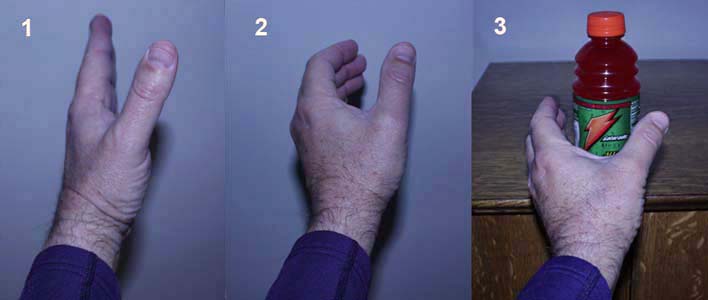
Author demonstrating the phenomenon of natural left wrist cupping/scooping
Image 1 shows an anatomically flat left wrist that accompanies the active stretching-out of the fingers, which automatically straightens/flattens the left wrist. Image 2 shows the natural left wrist cupping/scooping that occurs when the hand is in its "anatomical position of rest". Image 3 shows that the degree of cupping/scooping of the left wrist increases when grasping a wide rounded object that is straight-in-line with the left arm.
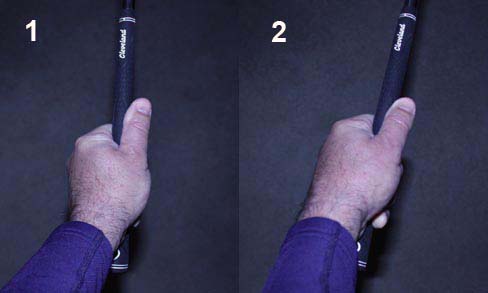
Author demonstrating a "flat left wrist"
Image 1 shows that the left wrist becomes slightly cupped/scooped when the left hand grasps a rounded grip - even if the left wrist is not bent (clubshaft is held straight-in-line with the left forearm). In this situation, the left wrist is geometrically flat (neutral left wrist).
To get the left wrist to appear to be anatomically flat, one has to palmar flex the left wrist slightly - image 2 - and in that situation the clubshaft is not in a straight-in-line relationship with the left forearm. Thisanatomically flat left wrist position is the desired position of the left wrist/hand at impact - when the hands are closer to the target than the clubhead (clubshaft has forward shaft lean). In other words, if a golfer has an anatomically flat left wrist at any time-point in his backswing/downswing, then it signifies that he has palmar flexed his left wrist slightly.
To get the left wrist to appear to be anatomically flat, one has to palmar flex the left wrist slightly - image 2 - and in that situation the clubshaft is not in a straight-in-line relationship with the left forearm. Thisanatomically flat left wrist position is the desired position of the left wrist/hand at impact - when the hands are closer to the target than the clubhead (clubshaft has forward shaft lean). In other words, if a golfer has an anatomically flat left wrist at any time-point in his backswing/downswing, then it signifies that he has palmar flexed his left wrist slightly.
Re-examine this swing video comparing Tiger Woods' and Adam Scott's swings - http://youtube.com/watch?v=ZecViQxUwss
Note that both Tiger Woods and Adam Scott maintain an anatomically flat left wrist (slightly palmar flexed left wrist) throughout their backswing/downswing.
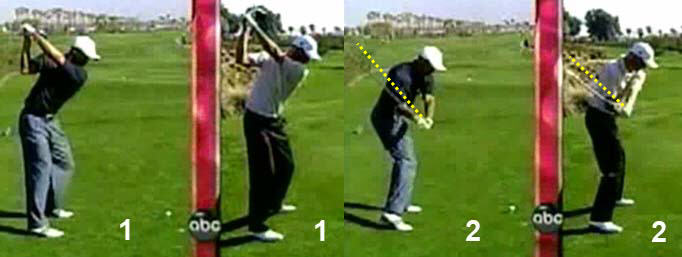
Tiger Woods and Adam Scott - capture images from their swing video
Image 1 shows that both Tiger Woods and Adam Scott have an anatomically flat left wrist at the end-backswing position. Because their left shoulder socket and left hand are roughly on the same plane, they can have the left arm and clubshaft in a perfectly straight-line left arm flying wedge relationship.
Image 2 shows that both Tiger Woods and Adam Scott maintain an anatomically flat left wrist during the mid-downswing - even though their left hand is much lower than the left shoulder socket. Note that both golfers had to slightly palmar-flex their left wrist to maintain an anatomically flat left wrist - and that causes the clubshaft to be shallowed-out slightly (the dotted yellow line represents the position where their clubshaft should be if it was in a perfectly straight-in-line left arm flying wedge relationship with the left arm).
Having an anatomically flat left wrist is not obligatory, and it is perfectly acceptable for a golfer to have a geometrically flat left wrist (neutral left wrist that appears slightly scooped/cupped) during the backswing/downswing.
What is not acceptable is having a bent left wrist - a cupped/scooped left wrist that is due to the clubshaft not being in a relatively straight-in-line relationship with the straight left arm (and where the left arm flying wedge straight-in-line alignment between the straight left arm and clubshaft is significantly altered).
What is not acceptable is having a bent left wrist - a cupped/scooped left wrist that is due to the clubshaft not being in a relatively straight-in-line relationship with the straight left arm (and where the left arm flying wedge straight-in-line alignment between the straight left arm and clubshaft is significantly altered).
I previously stated that the left wrist should remain flat (either anatomically flat or geometrically flat) during the backswing while the left wrist upcocks. During the backswing, the left wrist must upcock so that a golfer can establish a 90 degree relationhsip between the straight left arm and the clubshaft by the end of the backswing. Does the right wrist also have to upcock during the backswing - when the left wrist is upcocking?
Many golfers incorrectly believe that the right wrist also has to upcock during the backswing - if the left wrist upcocks. Also, many golf instructors teach this principle.
In his recent golf instructional book [2], Hank Haney states on page 68-: " Imagine you are standing at address. Now pick the clubhead straight up in front of your nose by hinging your wrists (figure 49). That is exactly the wrist motion you want to make in your backswing. Of course, it never looks like that in the golf swing because that motion is combined with your shoulder turn, your arm swing, and the rotation of your forearms". Here is figure 49 from his book [2].
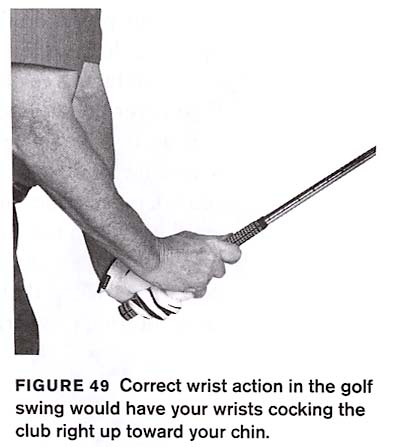
Note that Hank Haney is recommending that a golfer should upcock both the right wrist and the left wrist in the backswing. I think that Hank Haney is wrong, and I think that it is preferable to not upcock the right wrist during the backswing.
Consider the implications of cocking both wrists upwards in the backswing by viewing this swing video of Ryan Moore's swing -http://www.youtube.com/watch?v=_m3lCmj9yrU
Note that Ryan Moore cocks both wrists upwards in the backswing and that action causes his clubshaft to move off-plane and steepen considerably during the mid-late backswing.
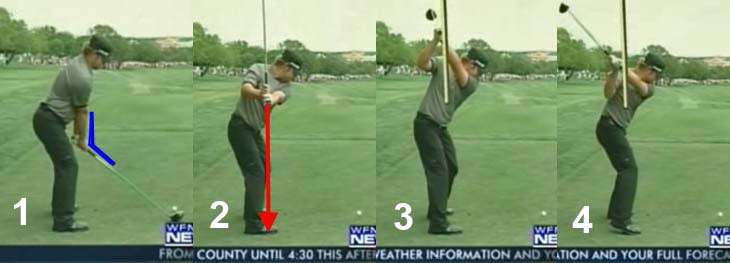
Ryan Moore's backswing action - capture images from his swing video
Image 1 shows that Ryan Moore has a relatively large power accumulator #3 angle - angle between his left arm and clubshaft (angle between the blue lines) - at address.
Image 2 shows that Ryan Moore cocks both wrists upwards during his mid-backswing and that causes his clubshaft to move off-plane (red arrowed line = an imaginary extension line extending from the butt end of the club, that points at his feet, instead of pointing at the ball-target line).
Image 3 shows Ryan Moore's end-backswing position - note that his left arm is angled steeply above his right clavicle and his hands are well above the right shoulder.
Image 4 shows Ryan Moore in his early downswing. Note how he drops his hands to a position behind his right shoulder and note how this action shallows his clubshaft and gets his left arm to lie along the shoulder turn angle. He is now in a perfect postion to start the downswing with an on-plane downswing action. (Source)


0 komentar:
Post a Comment